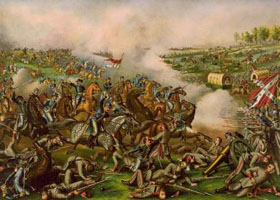 |
Civil War Battles |
|
State War Records |
| AL - AK - AZ - AR - CA - CO - CT - DE - FL - GA - HI - ID - IL - IN - IA - KS - KY - LA - MA - MD - ME - MI - MN - MS - MO - MT - NE - NV - NH - NJ - NM - NY - NC - ND - OH - OK - OR - PA - RI - SC - SD - TN - TX - UT - VT - VA - WA - WV - WI - WY |
The Battle of Five Forks
April 1, 1865 in Dinwiddie County, Virginia
 |
|||||||||||||||||||
|
The Battle of Five Forks was the third battle of the final spring campaign of the war. The Appomattox Campaign was fought westward from Petersburg through the counties of Southside Virginia.
By nightfall on March 31, the Confederate lines covering Petersburg were stretched precariously thin. Because of the Union flanking movement toward the Confederate right, Confederate troops had to be shifted westward to Five Forks, a road junction. Gen. Robert E. Lee moved 19,000 soldiers there, nearly 1/3 of his entire army, to oppose almost 50,000 Union troops. Two days of heavy rain and Confederate counterattacks near Dinwiddie Court House delayed the Union offensive. Lee and Maj. Gen. George C. Pickett, commanding that sector, knew that the Union onslaught would resume on April 1st.
Pickett crafted a line with his outnumbered defenders. Maj. Gen. W.H.F. "Rooney" Lee's cavlry division covered the Confederate right, or western, flank. Pickett's 5 infantry brigades manned the center, digging in along White Oak Road. He refused the flank of his left brigade, forming a hook, a disposition necessitated by a dangerous 3-mile gap yawning from the Five Forks line to the main Confederate works to the east. Pickett screened this break in the front with Brig. Gen. William P. Robert's weak cavalry brigade. Lee told pickett on the 1st that his line must be held "at all hazards".
For the last 3 days, these Confederates had opposed maj. Gen. Philip H. Sheridan's 3 Union cavalry divisions and 2 infantry corps, the II and V. Sheridan, pushed back to Dinwiddie Court House on march 31st, planned to assault the Confederate front while the V Corps, under Maj. Gen. Gouverneur K. Warren, stormed into the gap, rolling up Pickett's left.
Two Union cavalry divisions, commanded by Maj. Gen. George A. Custer and brig. Gen. Thomas C. Devin, initiated the action on April 1, pressing north into the wooded terrain. The cavalrymen fought dismounted except for 2 of custer's brigades. Brig. Gen. Ranald S. MacKenzie's cavalry brigade, meanwhile, reached the White Oak Road 3 miles east of Five Forks and veered westward across the gap. The Confederate skirmishers receeded before the Union cavalrymen, spilling into their main line. Sheridan, however, waited impatiently for Warren, whose advance had been delayed.
Once Warren arrived, Sheridan's cavalry pinned the Confederate force in position, Warren's V Corps attacked and overwhelmed the Confederate left flank, taking many prisoners. Warren met the first challenge by completing a 40 foot pontoon bridge across Gravelly Run by 2:00 A.M.. Troops, guns and supplies were moved through the mud towards the intersection of Five Forks. Sheridan personally directed the attack, which extended Lee's Petersburg lines to the breaking point. Loss of Five Forks threatened Lee's last supply line, the South Side Railroad. An hour before dawn, Pickett quietly pulled his men out of their camps to fortify the White Oak Road running through the Five Forks intersection. Brush and earth were used to forify "The Angle" on Pickett's right flank.
An hour before dawn, Pickett quietly pulled his men out of their camps to fortify the White Oak Road running through the Five Forks intersection. Brush and earth were used to forify "The Angle" on Pickett's right flank.
At dawn, Custer awoke to find the Confederates gone, and sent scouts to locate them 5 miles west of Lee's defenses around Petersburg and Richmond. Custer's men spent much of the day before the battle skirmishing the Confederate line along White Oak Road. Warren was to take a position south and east of "The Angle", then send word to Sheridan. Due to difficulties with the terrain and maps, Warren took longer to get into position than Sheridan anticipated. The final position of some of Warren's men was further north than expected, and they arrived to the battle behind Pickett's men defending The Angle.
Shortly before 4:00 P.M., Warren sent word to Sheridan that he was ready, and the Union troops over ran the 3-foot high fortifications at The Angle. Almost a thousand confederates were taken prisoner during the first few minutes of this battle. The battle was almost over by the time the sun set at 5:00 P.M. Sheridan sent word to Warren that he was to report to headquarters. His delays this day, compounded with other differences during the war, led Sheridan to relieve him of command.
On April 2, Lee informed President Jefferson Davis that Petersburg and Richmond must be evacuated. gen. Winthrop was killed; "Willie" Pegram, beloved Confederate artillery officer, was mortally wounded. Dissatisfied with his performance at Five Forks, Sheridan relieved Warren of command of the V Corps. Pickett escaped west from Five Forks with about 2,500 of his men. Pickett rejoined Lee's army when the reached Amelia Court Hourse.
